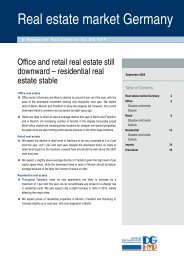ANNUAL REPORT 2006 - DG Hyp
ANNUAL REPORT 2006 - DG Hyp
ANNUAL REPORT 2006 - DG Hyp
Create successful ePaper yourself
Turn your PDF publications into a flip-book with our unique Google optimized e-Paper software.
Management Report<br />
strategy, monitoring the counterparty risk within the scope<br />
of granting and processing loans, early identification of<br />
potential risks in the lending business and intensified handling<br />
of distressed loans, plus restructuring and recovery of<br />
lending exposures through the corresponding procedures<br />
and control systems. Credit Treasury is responsible for credit<br />
risk management on a portfolio level. The management<br />
of market and liquidity risks is the responsibility of Treasury,<br />
within the scope of asset/liability management.<br />
Risk Controlling. Risk Controlling is responsible for<br />
current reporting and – together with the respective risk<br />
management unit – for monitoring risk on a portfolio level.<br />
This comprises quantifying the risk exposure, monitoring<br />
the quality and accuracy of data relevant to the risk exposure,<br />
monitoring the limit utilisations, and risk reporting to<br />
the Management Board. For this purpose, Risk Controlling<br />
prepares a MaRisk-compliant credit risk report on a quarterly<br />
basis, which outlines the key structural features of the<br />
lending business. A specific monitoring report for the retail<br />
business is produced on a quarterly basis, using scoring<br />
data generated from new business and behavioural scoring<br />
of the existing portfolio. An overall risk report is drafted<br />
monthly, which illustrates current credit risks as well as<br />
market risks and operational risk. Furthermore, Risk<br />
Controlling also carries out daily risk reporting on the<br />
market risks to which <strong>DG</strong> HYP is exposed, in accordance<br />
with MaRisk. Risk Controlling’s key findings are regularly<br />
reported to the Supervisory Board, or to the Risk and<br />
Participations Committee of the Supervisory Board. The<br />
regular portfolio evaluations are used to recognize<br />
abnormalities in the portfolio at an early state and counter<br />
these if required. In addition, portfolio evaluations form the<br />
basis for the annual review of the credit risk strategy.<br />
Internal Audit. The internal audit examines whether<br />
the demands on the internal controlling systems, the risk<br />
management and controlling systems, and the necessary<br />
reporting, are adequately met.<br />
d) Basel II<br />
The new Basel Capital Accord (commonly referred to as<br />
“Basel II”), implemented in the German Solvability<br />
Ordinance (Solvabilitätsverordnung – “SolvV”), which has<br />
come into effect as of 1 January 2007, is focused on<br />
securing the stability of the banking system and promoting<br />
banking supervision with greater qualitative focus.<br />
The core element of Basel II is greater risk-adjusted<br />
differentiation of the regulatory capital requirements for<br />
loans, depending on the credit quality of the borrower.<br />
All told, the planned regulations of the Basel Committee<br />
confirm our approach to a risk/return-oriented business<br />
and portfolio management. <strong>DG</strong> HYP will implement the<br />
Foundation Internal Rating Based Approach (FIRB) as part<br />
of Basel II. Developing our internal rating systems to<br />
implement the requirements of the Basel II Accord remains<br />
on schedule. In 2005, we concluded the implementation of<br />
all the internal rating and scoring processes required for<br />
adopting the FIRB.<br />
All projects involved in preparing for the introduction of<br />
Basel II have been run in close cooperation with the<br />
corresponding requirements for the DZ BANK Group since<br />
2003. They also correlate closely with the cross-institutional<br />
Basel II projects carried out by the Federal Association of<br />
German Credit Unions and Rural Banking Cooperatives<br />
(Bundesverband der Deutschen Volksbanken und Raiffeisenbanken<br />
– „BVR“ and the Association of German<br />
Pfandbrief Banks (Verband deutscher Pfandbriefbanken –<br />
„vdp“).<br />
The acceptance audit for the first entry level of FIRB<br />
from 1 January 2007 by the Bundesbank and the German<br />
Financial Supervisory Authority (Bundesanstalt für Finanzdienstleistungsaufsicht<br />
– “BaFin”) took place in the autumn<br />
of <strong>2006</strong> and was successfully completed, with confirmation<br />
of admission.<br />
Deutsche Genossenschafts-<strong>Hyp</strong>othekenbank AG | Annual Report <strong>2006</strong><br />
35














